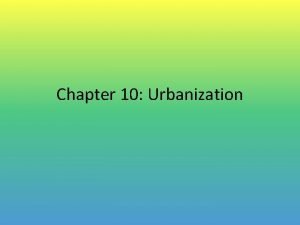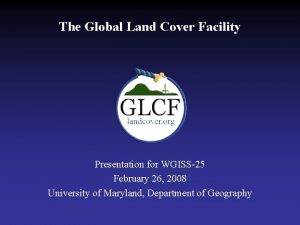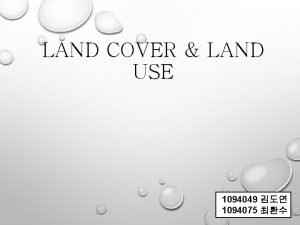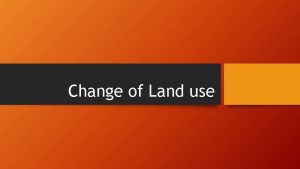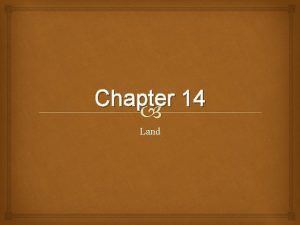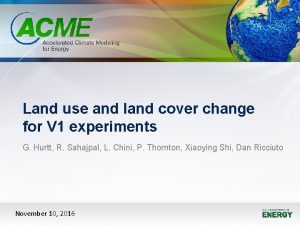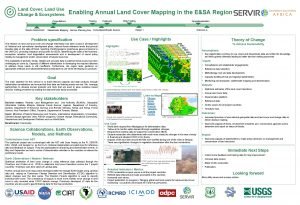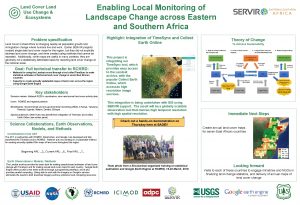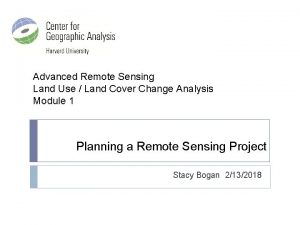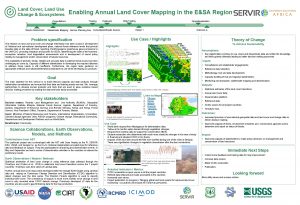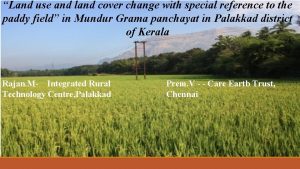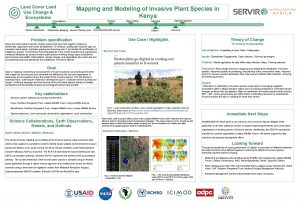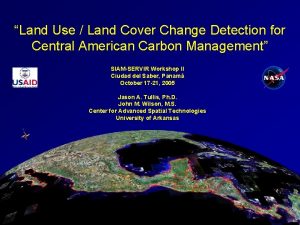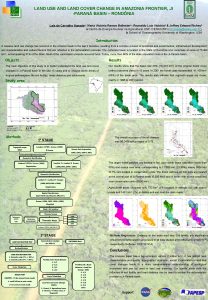Land Use Land Cover Change in the Phoenix




















- Slides: 20

Land Use / Land Cover Change in the Phoenix Metropolitan Area 1984 - 2011 Lori Krider & Melinda Kernik 1984 2011

Introduction • Why Phoenix? o One of 10 fastest growing cities from 1990 - 2000 (Perry & Mackun, 2001) o Arid regions with high population are water stressed o Water use is reflected by how the land is used and managed o How is the landscape changing and how does this effect water use?

Objective • Use remote sensing software to assess land use / land cover change in Phoenix from 1984 – 2011 o Expect to see dramatic changes due to rapid population growth § Increase in urban and suburban areas (sprawl) § Increase in cultivated areas on edges of metropolitan area § Decrease in natural vegetation

Objective • Study Area o Phoenix-Mesa Metropolitan Area § South-central Arizona § 16, 200 km 2 § Phoenix, Mesa, Tempe, Chandler, Gilbert, Scottsdale, Glendale, Sun City, Peoria, and Avondale Google Maps

Preparation • Tools: ERDAS IMAGINE 2011, USGS GLOVIS, Arc. GIS 10, Google Maps. TM and Google Earth. TM • Materials: Landsat TM images from 1984 and 2011 (two from each year, 30 m res. , 7 bands, June), 2006 NLCD • Pre-classification processing o o o Stack bands, mosaic and crop images for each year View NLCD Unsupervised classification (5, 6 & 7 classes)

Analysis • Supervised classification o Anderson Hierarchical Classification (levels 1 and 2) § Altered, unaltered, developed and water § Altered § Human-assisted: healthy and stressed crops, golf courses § Uncultivated: fields not reflecting in IR § Unaltered § Natural: upland scrub/shrub (not in IR) § Hydrophillic vegetation: depressional vegetation often associated with water (in IR) § Water: lakes, rivers and large golf course water hazards § Developed § suburban (dwellings) & urban/roads (commercial/industrial)

Analysis • Training Areas o o 15 - 45 Why? § Errors in first run with less training areas § Combination of smaller category classes (i. e. healthy crop + stressed crop) § Reduce confusion and capture variety • Change Detection o o Thematic: 1984 -> 2011 Difference § to identify areas of significant change and overall patterns § 10, 20, and 30% thresholds

Post-classification • Accuracy Assessment o o stratified random same mosaics as reference o o switched "trainers" 140 reference points (20 per class) § added Google Maps. TM for 2011 http: //www. cartoonstock. com/directory/b/bad_appraisal. as

1984 2011

Thematic Change Detection Purple: Change to Suburban Light Blue: Change to Urban

1984

2011

Purple = changed to Suburban Blue = changed to Urban

Green = more than 20% increase in NIR Blue = more than 20% decrease in NIR


Thematic Change Detection

1984 Limitations! 2011

Accuracy Assessment

For future classifications: • Clip to the smallest possible boundaries – More ontological classes = more classification confusion • Complications using 30 m resolution images for reference data and the same image. • Use this technique, to generate water infrastructure policy for Phoenix …probably not

References 1. Perry, M. J. & P. J. Mackun. Population Change and Distribution 1990 - 2000: Census 2000 Brief. April 2011. United States Census Bureau. 12 Nov. 2011. <http: //www. census. gov/prod/2011 pubs/c 2 kbr 01 -2. pdf>.
 Hirschburg test
Hirschburg test Cover uncover test vs alternating cover test
Cover uncover test vs alternating cover test Lancaster red-green test
Lancaster red-green test Land use certificate hyderabad
Land use certificate hyderabad Lesson 1 urbanization
Lesson 1 urbanization Glcf data and products
Glcf data and products What are landforms
What are landforms An area of land largely enclosed by higher land
An area of land largely enclosed by higher land Hát kết hợp bộ gõ cơ thể
Hát kết hợp bộ gõ cơ thể Ng-html
Ng-html Bổ thể
Bổ thể Tỉ lệ cơ thể trẻ em
Tỉ lệ cơ thể trẻ em Voi kéo gỗ như thế nào
Voi kéo gỗ như thế nào Glasgow thang điểm
Glasgow thang điểm Chúa yêu trần thế
Chúa yêu trần thế Các môn thể thao bắt đầu bằng tiếng bóng
Các môn thể thao bắt đầu bằng tiếng bóng Thế nào là hệ số cao nhất
Thế nào là hệ số cao nhất Các châu lục và đại dương trên thế giới
Các châu lục và đại dương trên thế giới Cong thức tính động năng
Cong thức tính động năng Trời xanh đây là của chúng ta thể thơ
Trời xanh đây là của chúng ta thể thơ Mật thư tọa độ 5x5
Mật thư tọa độ 5x5




